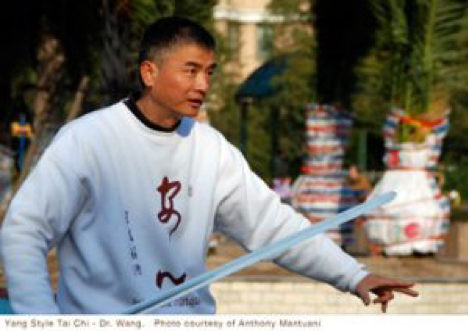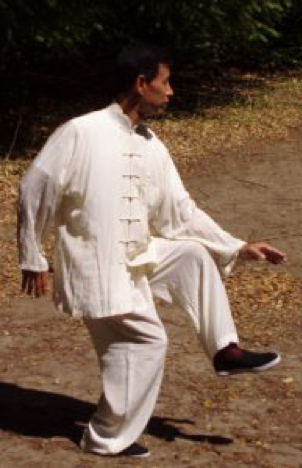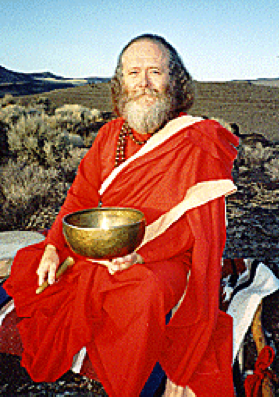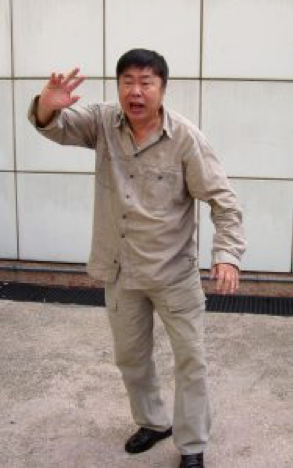One thing that I really admire about Asian cultures is their respect for teachers and the passing down of wisdom from one generation to the next. I have been fortunate enough to have a number of excellent teachers over the years. Please scroll down to find brief biographies of a few of the most influential teachers in my life.

Dr. Wang Zhi Xiang (王志祥) (b. 1960)
Dr. Wang Zhi Xiang began studying martial arts when he was 13 years old. He started studying Shaolin, but got tired of it in just a few months and switched to Xin Yi Liu He Ch’uan. For five years he studied Xin Yi, getting up every day at 4 am to make the one hour bike ride across Shanghai to the park where his teacher taught.
Then he began studying Ta’i Chi Ch’uan with Dong Bing. He continued to study Xin Yi along with T’ai Chi for the next three years before he stopped practicing Xin Yi to concentrate on T’ai Chi. He studied all aspects of T’ai Chi seriously, including san shou (sparring) and push hands. San shou practice included two against one, and three against one practice. Then one day he accidentally knocked out his cousin’s two front teeth. This made him rethink the martial arts. He decided that he should know how to use the martial aspect of Tai Ji, but not actually fight. Soon after this he decided to go to university to study Acupuncture. His work unit agreed to send him to the University.
After he began teaching T’ai Chi in Europe, Dr. Wang devoted himself full time to T’ai Chi practice. He would get up at 6:00 in the morning and practice for three hours before going to Cao Yang Park in Shanghai and pushing hands for two hours. Gradually he was becoming a popular person to push hands with and he began to return to the park in the afternoon for more push hands practice. After dinner in the evenings he would do standing meditation practice until ten or eleven o’clock. This schedule continued for three years.
For eight years Dr. Wang studied Wu style T’ai Chi Ch’uan with Wang Hao Da who taught in Cao Yang park. Several evenings a week Dr. Wang would go to Wang Hao Da’s home to study with him privately.
In the spring of 1997 Dr. Wang began studying with Wang Zhuang Hong. Wang Zhuang Hong was a native of Shanghai, but had moved to Hong Kong. At that time he was coming to Shanghai twice a year to visit his mother. He stayed for two weeks each time. When Wang Zhuang Hong’s mother became ill he was worried about her because he could only visit for two weeks at a time. He asked Dr. Wang to look after her. Dr. Wang assured his teacher that he would. He said, “I will treat your mother as I would my own.”
Currently Dr. Wang spends several months a year teaching in Europe, and he visited Wang Zhuang Hong every year until Wang Zhuang Hong passed away in 2009. The rest of the year he spends in Shanghai with his wife and young daughter. He researches the theories and principles of T’ai Chi, studies philosophy and meditates. He teaches a group of his close friends out of his home.

Qian Zhao Hong (钱兆鸿) (1947-2017)
Qian Zhao Hong (钱兆鸿) 1947-2017\Qian Zhao Hong was born in 1947 in an area of Shanghai that was considered a ghetto for Chinese Muslims. This area was rich with martial artists of a very high level. He happened to live across the street from Lu Song Gao, a Hui Muslim from Henan who brought the art of Xin Yi Liu He Quan (Heart-Mind Six Harmony Boxing) to Shanghai. Qian began his studies as a young boy and although he never took any single master as his only teacher, he has been recognized as one of Lu Song Gao’s disciples and a holder of Lu Song Gao’s lineage.
Lu Song Gao died in 1961 Master Qian continued to work with Lu Song Gao’s other students both as a teacher and as friends. Master Qian studied with many different teachers. Most important among them was his Shui Jiao (Chinese wrestling) teacher, Zhou Fenggeng. Master Qian had dropped out of school at a young age and it was Zhou Fenggang who made sure that he was literate and taught him to be a good person. In addition he studied Tong Bei, Ba Gua, Wu Dan Qi Gong, and he studied Spiral Taiji from its creator, Chen Jizheng.
Master Qian has been teaching for more than 30 years and has taught many highly successful martial artists, including push hands national champions and a silver medalist in a national free fighting competition. Master Qian himself has won many challenges in both push hands and free fighting, yet he emphasizes that long life, good health and mental well-being are much more important benefits of martial arts practice.

Swami Kntali Murugum Tayumanuvar (1940-2023)
Born Larry Shippen, Swami Ty was a native of a small town in north-eastern California. His first spiritual teachers were his grandmother and her best friend, who was a half Chinese, half Paiute shaman. When Swami left home to attend the University of San Francisco, he began to explore the spiritual teachings available in the city. He studied with a variety of spiritual teachers in those days, until he met Swami Subramunya.
Swami Tayumanuvar joined Subramunya’s order and studied with him for twelve years, residing in California; Virginia City, Nevada; Chicago, India, Sri Lanka, and Hawaii. Ultimately he left the order and returned home to attend to his elderly uncle.
Nowadays Swami Tayumanuvar taught in several locations around Northern California and Southern Oregon. In his teachings Swami Tayumanuvar emphasizes the Advaita philosophy of South Indian Shaivism, however he goes far beyond that and can converse eloquently on a huge range of spiritual topics, typically relating any topic back to the deepest principles of Advaita.
Advaita is a Sanskrit word which means “non-dual”. Advaita negates all dualistic conceptions which divide our Spiritual nature from the physical realms of experience. The deepest experience in Advaita is the meditative absorbtion (samhadi) in which the meditator experiences only consciousness, not a consciousness of an object, any object, outside of the self; but only Consciousness as the Self.
Ultimately, I would say that Swami Tayumanuvar has essentially transcended the limiting concept of “religion” in his teaching, and simply acts as a catalyst to his student’s own path, whatever that may be.

Wang Zhuang Hong 王壮弘 (1931-2007)
Wang Zhuang Hong was a native of Shanghai. He studied Yang Style Tai Ji Quan with Dong Ying Jie and Zhu Gui Ting, two of Yang Cheng Fu’s top ten students. Yet he became most famous for his calligraphy and painting. It is said that even Chairman Mao collected Wang Zhuang Hong’s calligraphy.
In 1985, one of Wang Zhuang Hong’s students moved to Singapore. As he began teaching there his own students praised his skill. His answer was, “I’m not that good, but my teacher is really good.” So they arranged for Wang Zhuang Hong to visit Singapore in 1987. Master Wang gave a lecture in an amphitheater to a large group of Tai Ji enthusiasts. After the lecture he was invited to one of the audience member’s home for further discussion of Tai Ji theory. The host complimented Wang Zhuang Hong on his lecture, but questioned whether he could really defeat people without using strength. When Master Wang said he could, they arranged a test.
The next day a group of Singapore’s Presidential bodyguards came over. Wang Zhuang Hong said that if they all agreed that he did not use any strength to defeat each of them, then he would teach them for a month for a fee, but if they felt he had used strength then he would teach them for free if they wanted him to. The end result was that everybody agreed that he had not used strength to defeat them. For a month Wang Zhuang Hong taught thirty some students in Singapore. Each student paid $100 USD a week. This was at a time when the average wage in Shanghai was 100 Chinese yuan (about $12.50 USD) per month, although Wang Zhuang Hong had his skills in calligraphy and painting that allowed him to earn 200 yuan per month.
His friends and students suggested that Wang Zhuang Hong shouldn’t go back to mainland China, but he didn’t know where he should emigrate to, so a friend took him on a tour of the world. When he came to the US, the famous author Nan Huai Jin gave him a tour of the country, including a trip to the White House and an audience with Ronald Reagan. President Reagan invited Wang Zhuang Hong to come to the US to teach Chinese culture to Americans, but Wang said that because he doesn’t speak any English, he felt that the language barrier would be too great.
And so he settled in Hong Kong. There he worked authenticating calligraphy and paintings for the museum and for private collectors. I met Wang Zhuang Hong in 2004 on a trip to Hong Kong with Dr. Wang. Although I was only able to spend a short time with him, he influenced me deeply. He was able to demonstrate very clearly that he used only energy to push, not physical strength.